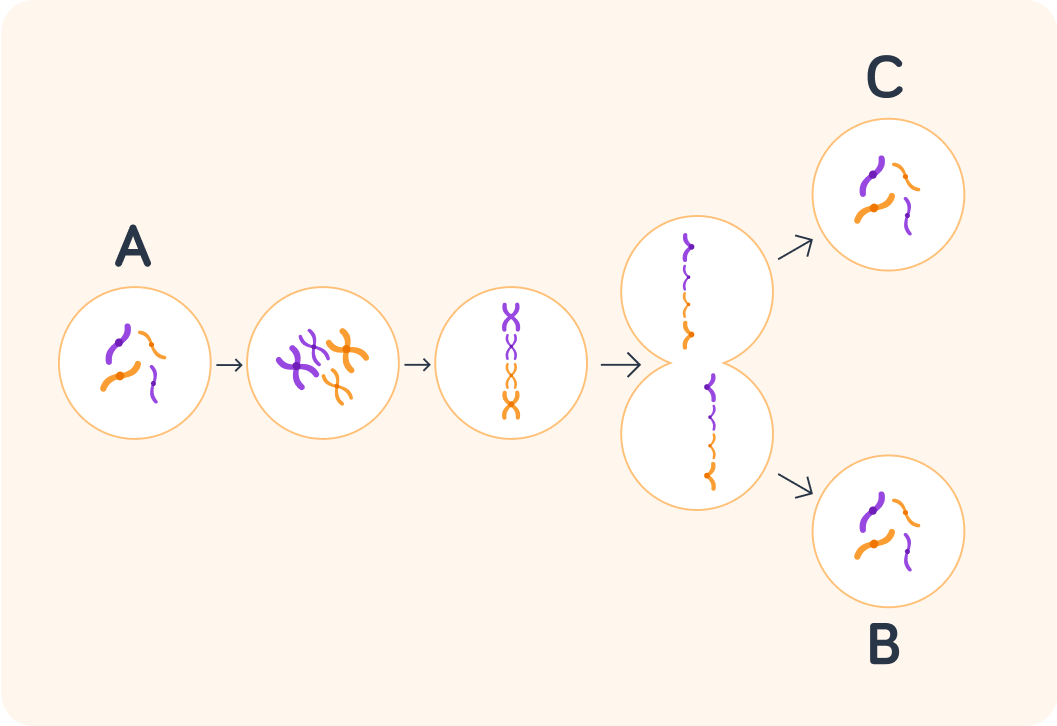YOU ARE LEARNING:
Sexual Reproduction

Sexual Reproduction
Sexual reproduction involves the fusion of gametes from two parents. These parents have gametes that can fuse (e.g. sperm and egg). Sexual reproduction has its advantages.
Sexual reproduction is the fusion of gametes to produce an offspring. In humans, an egg and sperm fuse to create a zygote, which quickly develops into an embryo. Do you think flowering plants have sperm and egg too?

Not all living organisms have sperm and egg. Flowering plants, for example, have ovules (eggs), but the male gamete is pollen.
Two gametes fuse during sexual reproduction, so the fertilised egg end up with...

In gamete production, meiosis (meaning "to lessen") halves the chromosome number. In regular cell division, mitosis, the number of chromosomes in the new cells are the same as the parent cell. During meiosis, the first step is actually mitosis.
After fertilisation, the newly formed zygote then divides by mitosis to grow in size. Once it reaches a certain size, it is classed as an embryo. What happens to the chromosome number during these divisions?

As the number of cells increases, how do they keep the same number of cells as the original parent cell?
A) The chromosomes copy themselves before dividing. B) The cells are smaller than the parent cell. C) The chromosomes copy themselves after dividing.
Answer A, B or C.


The original cells are referred to as the 'mother' or 'parent' cell.
The cells produced are referred to as the 'daughter' cells.

How many daughter cells are produced from one mother cell?


How does the number of chromosomes in cell B compare to cell A?
A) The same B) Half C) Double


How does the number of chromosomes in cell B compare to cell C?
A) The same B) Half C) Double


How many chromosome pairs are there in a human cell, dividing by mitosis?

This might help you remember what each type of cell division does.
Meiosis produces egg and sperm. Mitosis produces two identical cells.
After fertilisation, a zygote is formed. It divides, through mitosis, to form an embryo. The embryo cells differentiate, forming a range of cells in the new baby, from eye cells, brain cells and gut cells to skin cells.
So after fertilisation, cells differentiate into a whole range of cells. What do you think these cells can be called after differentiating?

If you have a cell dividing by mitosis, you will first have 1 cell of course. Then you will have 2 cells. How many cells next?

So, what's the point in sexual reproduction? Wouldn't it be easier to just clone yourself? Well, sexual reproduction does have a massive advantage over cloning.
You have genes from both your parents, and if you have a brother or sister, they have some differences in their genetic information (unless they are your identical twin). So sexual reproduction introduces genetic ____________ into offspring.

Natural selection and selective breeding.
Natural selection
Imagine that a new form of sunlight caused all blue-eyed tigers to go blind. They would not be able to hunt and survive, but brown-eyed tigers would be fine. So sexual reproduction introduces variation which gives some individuals an advantage. These individuals will pass their beneficial genes on to the next generation.
Selective breeding
Selective breeding essentially speeds up natural selection. For example, if we have some apple trees that produce many large apples and some trees that produce only very few, very small apples, we could breed only the trees that produce many large apples, so the offspring trees would be more likely to also produce many, large apples.
In what ways do you think we currently use selective breeding?

You can select multiple answers
